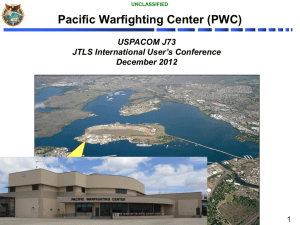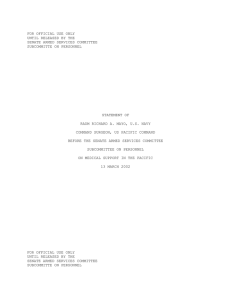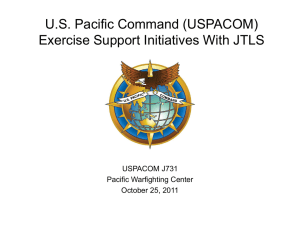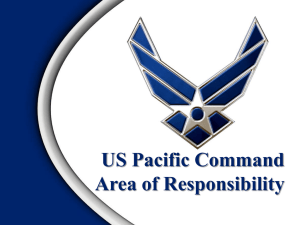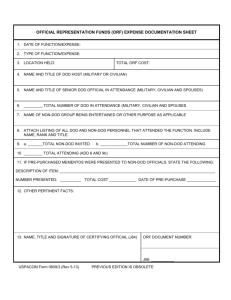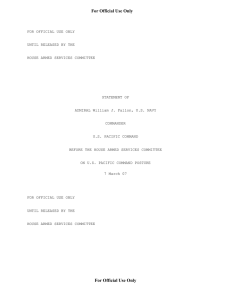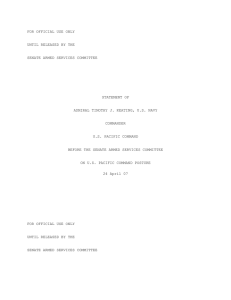SENATE ARMED SERVICES COMMITTEE STATEMENT OF ADMIRAL ROBERT F. WILLARD, U.S. NAVY
advertisement
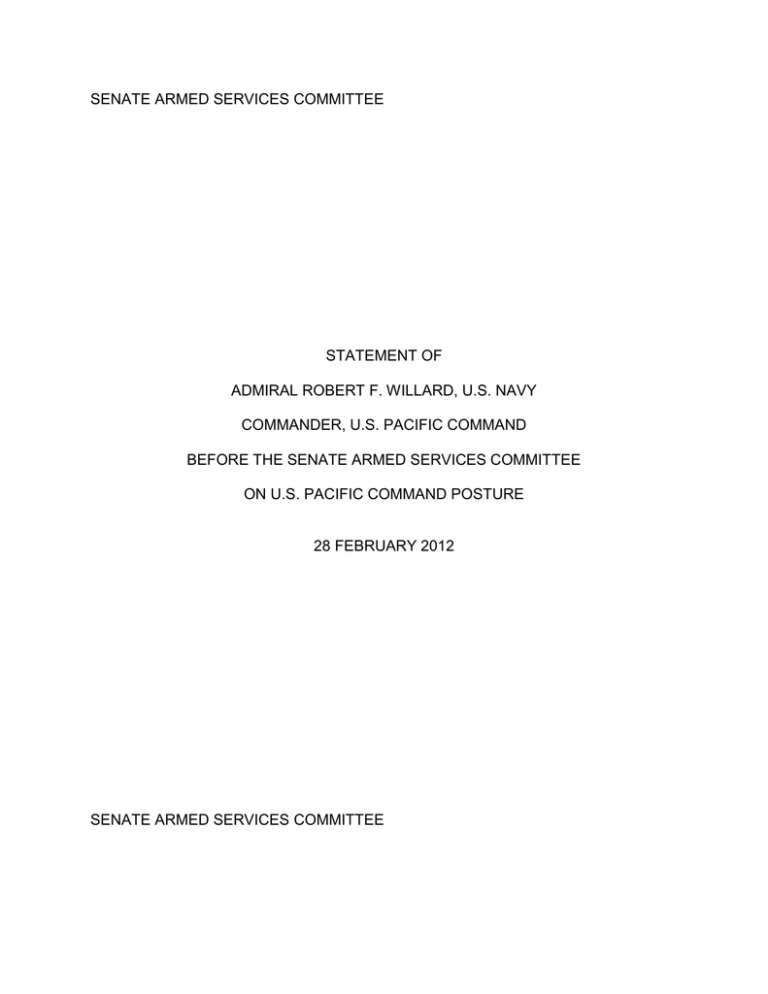
SENATE ARMED SERVICES COMMITTEE STATEMENT OF ADMIRAL ROBERT F. WILLARD, U.S. NAVY COMMANDER, U.S. PACIFIC COMMAND BEFORE THE SENATE ARMED SERVICES COMMITTEE ON U.S. PACIFIC COMMAND POSTURE 28 FEBRUARY 2012 SENATE ARMED SERVICES COMMITTEE Introduction Chairman Levin, Senator McCain and distinguished members of the Committee, thank you for this opportunity to present an update on United States Pacific Command (USPACOM). I consider myself fortunate to have served as its commander for the last two and a half years and look forward to providing what will be my final assessment of the strategic environment in the Asia-Pacific Region. The President has directed his national security team to make America’s ―presence and mission in the Asia Pacific a top priority.‖ The testimony that follows will highlight the opportunities we seek to illuminate and address the challenges we must overcome to sustain U.S. leadership in this critical area of the world. Strategic Environment in the Asia Pacific The security of the USPACOM Area of Responsibility (AOR) is of vital national interest to the U.S. - a fact underscored by the President’s hosting of last year’s AsiaPacific Economic Cooperation (APEC) Leaders Meeting. The region contains the world’s three largest economies and supports over 10 trillion dollars of annual bi-lateral merchandise trade, including more than 1 trillion dollars of U.S. commerce. The Asia Pacific also hosts the world’s largest populations, largest militaries, and includes three nuclear armed states (excluding the U.S.) and the Democratic People’s Republic of Korea (DPRK) which aspires to be a nuclear power. While the Asia Pacific has remained relatively peaceful and stable for the past six decades, myriad challenges to its future security will try U.S. resolve, raise the magnitude of our relationships with five treaty allies and many strategic partners, and test USPACOM as a principle guarantor of security in the region. 2 Seven major security challenges confront the U.S. across this region, which encompasses half of the earth’s surface, including: Defense of the homeland, U.S. territories and compact states in the Pacific. The need to continuously manage and optimize U.S. alliances and strengthen regional partnerships, in particular, advancing the relationship with India. The threat posed by the DPRK’s nuclear aspirations, proliferation, provocations, and potential to cause regional instability. China’s military modernization – in particular its active development of capabilities in the cyber and space domains - and the questions all these emerging military capabilities raise among China’s neighbors about its current and long-term intentions Three nuclear armed states, including Russia, China, and India, and North Korea’s nuclear aspirations, together with the threat of WMD proliferation Numerous transnational threats, ranging from proliferation, trafficking of narcotics and persons, and piracy, to persistent natural and manmade disasters Challenges to freedom of access to, and security within, maritime and air domains, and space and cyberspace, by both state and non-state actors. By contrast, the Asia-Pacific also affords immense opportunities, particularly through strong ally and partner associations, that can lead to a cooperative and constructive security environment for the foreseeable future. In large measure, 3 cooperative engagement activities leveraging USPACOM posture and presence contribute to advancing military self-sufficiency and security contributions by our partners in the region. Force Posture Assessment. Generally, USPACOM has been well served with regard to on-hand, ready forces with the ability to respond to the demands in the Asia Pacific region. This has occurred despite a decade of wars in the Middle East, to include the Command’s continual contributions to those wars. As a consequence of both history and the nature of challenges in Northeast Asia, USPACOM forward, permanently based forces are concentrated in Japan and the Republic of Korea. While affording a strong deterrent against challengers such as North Korea, this has placed a premium on USPACOM’s ability to deploy and sustain forces elsewhere in order to maintain the required presence in sub-regions such as Southeast Asia, South Asia and Oceania. USPACOM’s input to the most recent Global Posture Review expressed a need to redistribute postured forces closer to Southeast Asia and South Asia, in order to more efficiently meet the force presence and response demands of those Asia Pacific subregions. The recent decisions to rotationally operate a Marine Air Ground Task Force (MAGTF) from Darwin, Australia and to operate U.S. air forces from Australia’s northern air bases were initial efforts to rebalance USPACOM force posture for the future. While the Asia Pacific is often regarded as inherently maritime and contains some of the world’s most expansive archipelagos, strategic chokepoints and largest seas and oceans, its militaries tend to be army-focused. For USPACOM, this generates posture and presence considerations to both adapt forces to the maritime challenges of 4 the region and to account for the necessary and effective role that Army, Marine Corps, and Special Forces play in engaging with the dominant foreign services of our regional partners. Northeast Asia Northeast Asia (NEA) contains many of the most significant economies and militaries in the Asia Pacific and the world, including Japan, South Korea, China, and Russia. U.S. forward presence, permanent basing in Japan and South Korea, habitual accesses, and host nation support in this important sub-region enable USPACOM’s front line of homeland defense, extended deterrence for allies Japan and South Korea, regional deterrence against actors such as North Korea, and rapid response to natural disasters and other contingencies that occur in the Asia Pacific. The DPRK continues to pose one of the most likely and persistent threats to the United States, its allies, and to peace and security in Northeast Asia. North Korea’s conventional military threat to the Republic of Korea remains of serious concern and its nuclear program, missile development, proliferation activities, and asymmetric military provocations are destabilizing. Collectively, these threats demand that USPACOM Intelligence, Surveillance, and Reconnaissance (ISR) capabilities and capacities be sufficiently robust to view across the DPRK’s military apparatus and warn of unfavorable developments. North Korea’s continuing pursuit of nuclear weapons and advanced ballistic missile systems places a premium on USPACOM ballistic missile defenses and close cooperation with allies. Japan and the ROK are strong U.S. allies that host U.S. forces, benefit from U.S. extended deterrence, and stand with the U.S. in 5 containing DPRK aggression in addition to meeting other regional and global security challenges. Japan. The 52-year old alliance between the U.S. and Japan remains a cornerstone of security in the Asia Pacific. As was evident in U.S. support to the Japanese Self Defense Forces (JSDF) during the epic triple disaster in eastern Honshu last year, the extremely close association and inherent interoperability between tenant U.S. forward forces and their Japanese hosts enable prompt and extremely effective contingency responses under the most trying of circumstances. Despite delays in implementing some elements of the Defense Policy Review Initiative (DPRI), including the Futenma airfield replacement facility in Okinawa, which has occupied policymakers for nearly 20 years, the alliance remains strong and is a powerful strategic stabilizing force in the region. It is important to note that of the 19 separate elements contained in DPRI, the vast majority are on track and progressing. In the past year, Japan has increased its regional engagements and association with partners such as Australia, India, Singapore, Indonesia, and the ROK, to name a few. Republic of Korea (ROK). The U.S.-ROK alliance remains a strong and visible deterrent to war on the peninsula. This alliance is also transforming in a variety of ways to remain current and relevant in the midst of an ever-evolving Asia Pacific region, changing leadership in North Korea and as a consequence of lessons learned following the deadly provocations by the DPRK in 2010. Current alliance initiatives are underpinned by the planned transition of wartime operational control from the Combined Forces Command to the ROK in December 6 2015. Ongoing transformation also includes the repositioning of on-Peninsula U.S. forces, headquarters, and bases. Like the JSDF, ROK military forces are engaging throughout the Asia Pacific at an increasing rate, and contributing to international security initiatives, such as peacekeeping, counter-piracy, and counter-proliferation efforts. Trilateral Cooperation. While modest in scope, trilateral cooperation between the U.S., Japan and the ROK continues to progress. This important initiative seeks to strengthen the natural synergy among three powerful and interoperable Northeast Asia allies. While the countries will have to overcome longstanding historical, cultural, and political dynamics to fully realize the potential of trilateral cooperation, policy advances and increasingly frank dialogue among the three allies are encouraging. Russia. Russia’s Pacific armed forces are very gradually emerging from their diminishment following the end of the Cold War. Increased naval and strategic air force operations, cyberspace activities, and arms sales throughout the Asia Pacific are signaling Russia’s emphasis on improved posture in the region. USPACOM enjoys a generally positive military-to-military relationship with Russia, particularly between respective Pacific fleets. In coordination with United States European Command and in accordance with the bilateral Military Cooperation Work Plan, USPACOM seeks improved engagement with Russia’s Pacific forces in areas such as counter terrorism (CT), peacekeeping, and search-and-rescue operations. Mongolia. Mongolia is a small but important partner in Northeast Asia. Its active military pursues close engagement with USPACOM through our annual KHAN QUEST exercise series and contributes effectively to coalition efforts in Afghanistan as well as 7 global peacekeeping operations. With Russia to the north and China to the south, Mongolia must finesse its relationships in NEA with its broader security interests. As a consequence of its experience as part of the Soviet bloc in the 20th century, the Mongolian armed forces continue to maintain ties to European nations such as Germany and even the DPRK, making them a USPACOM partner with unique and insightful perspectives. The People’s Republic of China. China’s growing presence and influence in Asia, and the opportunities and uncertainties that have resulted from it pose the greatest test for USPACOM among its seven challenge areas. In January 2011, President Obama and Chinese President Hu Jintao agreed to ―build a cooperative partnership based on mutual interest and mutual respect,‖ which also included a commitment to develop ―continuous, stable, and reliable military-tomilitary relations.‖ To meet this mandate, USPACOM is effectively positioned to contribute to advancing military engagement with the PRC. However, military-to-military relations continue to lag well behind other U.S. - China engagements for three main reasons: differences in philosophy regarding the purpose of military-to-military relations in which China emphasizes strategic dialogue and the U.S. seeks comprehensive military contact from the strategic to tactical levels as a way to build confidence; China’s tendency to suspend military-to-military following U.S. arms sales to Taiwan and, more generally, its linkage between certain U.S. defense policies and continuous bilateral military relations; and inherent Chinese distrust of U.S. regional intentions resulting in demands that perceived impediments to the relationship be conceded before military relations can advance. 8 Despite these challenges, China’s increasing participation in regional and international security activities and forums such as multi-lateral exercises, counter piracy operations, and peacekeeping can foster informal, but useful U.S. – China military engagement. Improvements in China’s military capabilities and the regional uncertainties this has created also test USPACOM’s ability to manage the evolving security dynamics in the Asia Pacific. Areas in which U.S. national interests or those of U.S. allies and partners are being challenged include cyberspace and space as well as maritime security in the international waters around China. China’s anti-access/area denial (A2/AD) capabilities extend well into the SCS. China asserts these military developments are purely defensive in nature and that it poses no threat to neighbors in the region. Yet, combined with broad maritime and sovereignty claims and incidents with lawful operators in the SCS and ECS, there is ongoing international concern regarding China’s activities in the South China Sea. Taiwan. Following Taiwan’s recent Presidential and Legislative Yuan elections in January 2011, many analysts are hopeful that improvements in cross-Strait relations will continue, with a focus on building economic and cultural ties. This is in the security interests of the United States and of Asia. It is important to note, however, that Taiwan remains the most acute sovereignty issue for China and the main driver of its military modernization programs. The military balance across the Taiwan Strait continues to shift in favor of China. USPACOM engages regularly with Taiwan’s military within policy guidelines and in accordance with tenets of the Taiwan Relations Act and three communiqués. 9 Southeast Asia Southeast Asia (SEA) is an extremely diverse sub-region, rich in natural resources, and strategically located at the crossroads of the Pacific and Indian Oceans. It is host to a mix of democratic and authoritarian governments, varied economies, contrasting military capabilities, and mixed cultures. Prospects for continued economic growth are promising, mainly due to China’s substantial economic influence, steady U.S. regional investment and trade, and universal global interest, by the European Union and others, in capitalizing on Asia’s rise. Many advancing U.S. partnerships and two U.S. treaty allies, the Republic of the Philippines and the Royal Kingdom of Thailand, are concentrated in this sub-region. Further, the Association of Southeast Asian Nations (ASEAN) and its numerous forums, together with the East Asian Summit (EAS) and APEC, have advanced to become the most effective Asia Pacific multilateral organizations. That said, SEA is not without its challenges. Disputed islands and features in the SCS, including territorial disputes with China, have generated broad unease in SEA, and maritime security has become a regular theme in multilateral forums. Transnational threats, including violent extremist organizations (VEOs) such as Abu Sayyaf Group (ASG) and Jemaah Islamiya(JI); trafficking in narcotics and humans; piracy; proliferation; and natural and manmade disasters regularly combine to challenge USPACOM, U.S. allies and partners in this sub-region. Resources such as water, food and energy are being pressurized across the region, as illustrated by the Mekong River Delta crisis. Geography is also a factor as SEA contains some of the most extensive 10 archipelagos in the world, including Indonesia and the Philippines, and some of the world’s most strategic choke points, such as the Strait of Malacca. Despite this vast maritime domain where naval capabilities and capacities are called for, most SEA militaries are army-centric and assigned internal security responsibilities. Consequently, few nations are self-sufficient militarily. USPACOM’s has focused its engagement on advancing the self-sufficiency of the partner militaries in the region. Programs such as International Military Education and Training (IMET) are vital to enhancing the education level of military leaders and promoting a network of military-tomilitary relations that contribute to broader security cooperation in SEA. Philippines. Underpinned by the 1951 Mutual Defense Treaty, the U.S.Philippines alliance is an important strategic icon in SEA. Adjoining the SCS, this vast island nation straddles several strategic sea lines of communication (SLOCs) and chokepoints, claims a number of disputed islands and features in the SCS, and contends with several internal insurgent movements and VEOs, such as JI and ASG, with assistance from U.S. forces. Possessing an army-centric military as a result of its internal security challenges, the Philippines has recently begun to focus on improving the ability of its navy and air forces to secure the vast maritime area defined by the Philippine archipelago. As a consequence, USPACOM security assistance is focused primarily on supporting the Armed Forces of the Philippines (AFP) in CT efforts in southern Mindanao and the Sulu archipelago, and advancing AFP naval and air capabilities. Improving maritime domain awareness is another primary focus of U.S. security assistance, and we hope to provide a second Hamilton-class Coast Guard cutter to the Philippines this year. 11 Joint Special Operations Task Force-Philippines has operated in a strictly noncombat role in support of the AFP for the past 8 years in the largely successful efforts to contain ASG and JI VEOs. Additionally, USPACOM engages with the Philippines through the Joint Staff-sponsored exercise BALIKATAN, as well as through annual military-to-military consultations, periodic PACIFIC PARTNERSHIP missions, and numerous service component-led exercises. We welcome recent U.S. – Philippine discussions regarding opportunities to increase joint training with our AFP counterparts, possibly supported by enhanced rotational access to AFP facilities by USPACOM forces. Thailand. I would begin by offering my personal condolences to the Thai people for the losses they suffered in 2011 during the most devastating flood their country has experienced in 50 years. Their response to this disaster, particularly with regard to containment of potential infectious diseases, was a testament to Thailand’s resilience and self sufficiency. Thailand is an enduring U.S. ally in SEA and a valuable security partner. They are co-host (with USPACOM) to the largest multilateral exercise series in SEA, COBRA GOLD, and provide liberal access and logistics support for transiting USPACOM aircraft and ships at their military facilities. The U.S. and Thailand have twice partnered to combat piracy off the Horn of Africa, deploying Thai naval vessels with U.S. Navy personnel onboard to Combined Task Force-151, which Thailand will take command of in the coming year. Additionally, the Royal Thai Army assisted UN humanitarian relief operations in Darfur with a battalion of peacekeepers. 12 Despite facing challenges such as land and maritime border disputes with neighboring, Cambodia, refugee incursions from Burma, a longstanding ethnic insurgency in the south, and transnational challenges such as narcotics and human trafficking, the Thai armed forces are capable and generally self-sufficient. Singapore. Our bilateral relationship with Singapore continues to strengthen and broaden. Singapore armed forces comprise a small, but extremely capable military. Their main focus continues to be security within the Strait of Malacca and Singapore Strait and they cooperate with Indonesia, Malaysia and Thailand in conducting security patrols within the Straits against piracy and other illicit activities. Singapore’s armed forces are also deployed to Afghanistan, working alongside coalition partners to develop the Afghan National Security Forces. Within the context of the 2005 Strategic Framework Agreement, both militaries are seeking to increase engagement across all USPACOM service components. Singapore’s offer to host U.S. Littoral Combat Ships (LCS) at Changi naval station will enhance USPACOM’s SEA posture. Indonesia. As the relationship between the U.S. and Indonesia—the world's fourth most populous nation, third largest democracy, and largest Muslim-majority country—continues to advance, the USPACOM – TI relationship is progressing, as well. Following a decade of political, economic, and military reform, Indonesia has surfaced as a vibrant democracy, an emerging economy, and a competent military power. In areas such as disaster risk reduction, CT, Humanitarian Assistance/Disaster Relief (HA/DR), and peacekeeping operations, Indonesia is increasingly recognized for its leadership role. Indonesia and the U.S. were recently designated co-chairs of the Experts Working Group on Counter Terrorism for the ASEAN Defense Ministers 13 Meeting - Plus. This initiative seeks to encourage greater regional CT cooperation, build capacity, and collectively address regional security issues in an open consultative forum. Following a 12-year hiatus, USPACOM has reestablished security cooperation activities with the Indonesian KOPASSUS army special forces. The measured pace with which this engagement has advanced has included key leader dialogue and smallscale subject matter experts exchanges in areas such as military decision making, medical planning and law of war / human rights. More activities of this type are planned for 2012 and will gradually expand at a pace commensurate with the demonstrated progress in Indonesian Armed Force transparency and institutional reform. Vietnam. Military relations with Vietnam continue to grow in areas such as disaster management, search and rescue, conflict resolution, personnel recovery and medical operations. Vietnam is modernizing its military and looks to the U.S. as a partner in maintaining security and stability in SEA, particularly in the SCS. Vietnam’s successful chairmanship of ASEAN in 2010 affirmed its emerging role as a leader and spokesman among SEA nations, as has been evidenced by their current role in lower Mekong River delta HA/DR initiatives. Vietnam and China have a long history of competition in the SCS. Both nations’ disputes over islands and features, as well as natural resources, have led to confrontations in the past. Vietnam’s continued leadership among SEA nations will be a critical component of eventual conflict resolution in this highly important and strategic area. USPACOM will carry on working closely with Vietnam to advance our military relationship and cooperation in providing 14 security across the Asia Pacific while remaining mindful of concerns about human rights. Malaysia. Malaysia’s vibrant economy, advanced military, strategic position near Malacca and the Singapore Straits, bordering both the SCS and Indian Oceans, and regional leadership combine to define it as an important partner for the U.S. and USPACOM, and a key actor within SEA. Malaysia contributes to Strait of Malacca patrols, maritime security in the SCS, and efforts to contain transnational threats, such as piracy, and VEOs, such as ASG and JI. Its direct action against pirates in the Gulf of Aden was evidence of increased confidence and capability. In 2011, Malaysia conducted its second deployment of medical support units to Afghanistan and remains committed to supporting coalition efforts there until 2014. U.S. naval vessels frequently call in Malaysian ports, and military-to-military exchanges and joint training have expanded over recent years. Cambodia, Laos, Brunei and Timor-Leste. The U.S. has extensive interests across the rest of SEA, and USPACOM seeks to continue advancing military relations with Cambodia, Laos, Brunei, and Timor-Leste. Cambodia has been a strong supporter of U.S. military engagement in recent years and demonstrates a strong desire to increase military-to-military activities with USPACOM. Military engagements with Brunei, Laos and Timor-Leste have expanded, albeit modestly, over the past year with particular emphasis on relationship-building and enhanced regional cooperation. Burma. To the extent that any military-to-military relationship exists with Burma, it is extremely limited due to U.S. policies and sanctions directed at the former junta and its actions. However, the Burmese government steps towards credible political and 15 economic reform and working toward ceasefires with armed ethnic groups in the past several months together have improved U.S.-Burma ties, resulting in several initiatives announced during Secretary Clinton’s December trip to Burma. Prisoner of War (POW)/Missing in Action (MIA) recovery operations, is the first opportunity for militaryrelated engagement with Burma since 2004. It is estimated that the WWII remains of as many as 730 Americans may be present there. Burma’s assimilation into the broader Asia-Pacific regional security order would be a positive event.. South Asia South Asia as a whole is of major strategic importance to the U.S. Anchored by India and containing major SLOCs for the transport of energy and other commerce to Asia and the Americas from the Middle East and Europe, South Asia security partnerships are increasingly vital to USPACOM’s mission. South Asia is home to a confluence of challenges, including nuclear armed rivals India and Pakistan, numerous transnational VEOs such as Lashkar-e-Tayyiba (LeT), piracy, trafficking in narcotics and persons, disputed borders, and insurgent movements that have plagued India, Nepal, and Sri Lanka. South Asia is particularly prone to natural disasters, including cyclones, tsunamis, and earthquakes. Bangladesh has long suffered from annual cyclones and flooding and Nepal is expected to suffer a major earthquake in the coming years. USPACOM engages throughout South Asia, assisting its militaries to counter and contain VEOs such as LeT, cooperating in maritime security activities such as counter piracy, conducting disaster response planning and training, and exercising extensively, service to service. 16 India. Pursuing a U.S.-India strategic partnership through a close alignment of respective regional security interests is a priority for the U.S. Department of Defense and USPACOM. Our security relationship involves strategic to tactical-level dialogues, increasingly robust military exercises, security assistance, and personnel exchanges. The United States and India have made steady progress in military-to-military cooperation over the past decade. It is important that the leadership and staffs of USPACOM and United States Central Command continue to coordinate our respective military activities in this subregion, especially as they concern India and Pakistan. Bangladesh. Bangladesh has emerged as a particularly effective partner in the fight against terror, cooperating with India as well as the U.S. to counter VEO activity by actors such as LeT. Further, Bangladesh’s military is advancing its capabilities and contributes broadly to UN peacekeeping operations. Also, the Bangladesh army is primarily responsible for and has achieved major advancements in the protection of its citizens during the annual cyclone season and the inevitable flooding and related disasters with which Bangladesh repeatedly contends. Maldives, Nepal, Sri Lanka. Although South Asian nations share similar concerns and challenges, they are uniquely individual. Due to its proximity to major commercial sea lanes, the Maldives is concerned with piracy and other illicit activity in its Exclusive Economic Zone (EEZ). For that reason, it is striving to advance its maritime security capabilities by reshaping its coast guard, marine and special operations forces. Further, curbing recruitment of its youth into VEOs and narcotics trafficking and addiction are Maldives’ areas of focus. 17 Nepal has emerged from a lengthy Maoist insurgency in 2006 and is seeking to integrate some of the former insurgents into the Nepal Army In partnership with USPACOM, Nepal’s armed forces are preparing to respond to a future earthquake. Sri Lanka, too, is focused on developing its maritime security capabilities while preventing a resurgence of the Liberation Tigers of Tamil Elam. Sri Lanka’s military forces continue to assist in de-mining and other recovery operations following 25 years of civil war. USPACOM’s engagement with Sri Lanka will continue to be limited, until the Government of Sri Lanka demonstrates progress in addressing human rights allegations. Each of these nations’ militaries partner with USPACOM at varying levels, including leadership exchanges, exercise series, USPACOM Assist Team CT capacity building actions and activities, and security assistance. LeT. While several VEOs conduct facilitation, recruitment, and seek safe havens throughout South Asia, LeT presents a particularly acute problem. Responsible for many attacks in India, including the horrific attacks into Mumbai, LeT is headquartered in Pakistan, affiliated with Al Qaida and other VEOs, and contributes to terrorist operations in Afghanistan and aspires to operate against Asia, Europe and North America. USPACOM’s FY11 Indian Engagement Initiative that resourced and hosted Mumbai CT specialists for training, exercises, and exchanges throughout the U.S., together with capacity-building activities with South Asian partners are mainly focused on containing LeT and contributing to CT self-sufficiency of the sub-region’s militaries. 18 Oceania The U.S. alliance with Australia anchors USPACOM’s strategy in Oceania. Australia, with additional contributions from New Zealand, invests extensively in security and assistance efforts in this sub-region. The Australian continent notwithstanding, most of Oceania is comprised of Pacific Island nations spread across the vast expanse of the South Pacific Ocean. Security challenges associated with natural resources in this sub-region tend to predominate. In particular, illegal fishing, resource damage attributed to climate change and global warming, and the susceptibility of low lying island nations to typhoons and tsunamis define USPACOM and U.S. Coast Guard approaches to engagement in Oceania, often in concert with Australian and New Zealand actions. Two new Shiprider Agreements with the Pacific Island nations of Nauru and Tuvalu together with those already in place with the Marshall Islands, Micronesia, Palau, Tonga, and Kiribati enable transiting U.S. ships to assist in characterizing the maritime domains and providing a mechanism for shiprider-nation responses to irregularities within these island nations’ territories. Oceania is also home to the Compact of Free Association nations of the Republic of Palau, the Federated States of Micronesia, and the Republic of the Marshall Islands, each of which USPACOM is obligated to defend as part of Compact arrangements putting their territory off limits to all armed forces except those of the United States (and other countries we have invited). Compact agreements with these three nations provide USPACOM a strategic buffer along the southern flank of the highly strategic U.S. territory of Guam. USPACOM is increasing its collaboration with the Department of the 19 Interior which administers federal policy in U.S. territories in Oceania and administers assistance funds to the Compact Nations. We soon expect to have a liaison officer from Interior join the USPACOM staff. Australia. The U.S.-Australia alliance, our most significant partnership in Oceania, benefits from two new force posture initiatives, the rotational deployment of a Marine Air Ground Task Force (MAGTF) to Darwin and enhanced access to airfields in northern Australia. These initiatives will enable deeper interoperability of our respective forces, expand training opportunities with third countries in the region, and improve access to SEA and Oceania. Australia is also the largest non-NATO contributor of forces to the coalition efforts in Afghanistan. A trilateral relationship between Australia, Japan, and the U.S. continues to advance and has the potential to enable multilateral approaches to the region’s challenges. Bilaterally, the U.S. and Australian militaries collaborate extensively in areas such as information sharing; ISR; HA/DR; combined arms training in exercise TALISMAN SABER; and space and cyber security. New Zealand. New Zealand is also a recognized leader in Oceania. It is a strong partner of the U.S., and in accordance with the forward-looking spirit of the 2010 Wellington Declaration, USPACOM will continue to look for ways to further strengthen the relationship despite differences over nuclear policy. The U.S. and New Zealand share many security concerns and are cooperative partners in areas such as intelligence sharing, HA/DR and maritime security. In the interest of advancing the partnership, New Zealand is participating fully in the Rim of the Pacific (RIMPAC) exercise for the first time in 2012. 20 We value New Zealand’s contributions to Afghanistan. New Zealand also supports stabilization efforts in Timor-Leste and the Solomon Islands, Armistice enforcement in Korea, and UN peacekeeping efforts globally. Exercise and Engagement Programs Exercises. In order to maintain ready forces and to plan, train, and exercise to accomplish the full range of military contingencies, USPACOM requires annual Congressional support for the Combatant Command Exercise and Engagement (CE2) program. USPACOM’s portion of this essential program consists of 18 major exercises involving joint military forces, interagency activities, and 27 of 36 USPACOM partner nations. CE2 directly impacts USPACOM’s ability to conduct Joint training exercises and theater security engagement events across the Asia Pacific, and therefore plays a vital role in contributing to security of the AOR. Engagement Programs. Two very significant engagement programs are PACIFIC PARTNERSHIP and PACIFIC ANGEL. In 2011, the USS CLEVELAND, with personnel from 11 nations, conducted a 4-month deployment to Tonga, Vanuatu, Papua New Guinea, Timor Leste, and Federated States of Micronesia. Combining medical, dental, and engineering support, the mission treated over 38,000 patients, conducted scores of community relations projects, and completed much needed engineering and infrastructure repairs. Likewise, PACIFIC ANGEL ’11, utilizing C-17 aircraft, cared for thousands of patients and completed numerous civic action projects in Mongolia, Cambodia, Timor Leste, and Indonesia. Both of these engagement programs serve to improve regional partnerships, while enhancing the resiliency of object nations to deal more effectively with their own 21 humanitarian crises due to natural disasters or other causes. Moreover, the experience that our service components gain by working alongside non-governmental organizations and other participating militaries in these controlled conditions improves their abilities to conduct disaster response when time is of the essence and lives are on the line. USPACOM considers PACIFIC PARTNERSHIP and PACIFIC ANGEL to be high payoff engagements in the Asia Pacific region. Global Security Contingency Fund (GSCF) The GSCF is a new tool available for USPACOM and country teams to develop and deliver security sector assistance in a coordinated fashion, enhancing the capabilities of military forces, other security forces, and relevant government agencies. The fund also supports the justice sector (including law enforcement and prisons), rule of law programs, and stabilization efforts. USPACOM Organizations The following direct-reporting units (DRUs) uniquely contribute to the USPACOM mission: Asia-Pacific Center for Security Studies (APCSS).APCSS fills a unique role in multi-national security cooperation and capacity-building efforts by equipping and empowering APCSS fellows and alumni to make substantive changes to their countries’ security architectures. APCSS brings together communities of interest and influence, comprised of presidents, vice-presidents, ministers of defense and foreign affairs, chiefs of defense, and ambassadors, to enable collaborative solutions to critical regional security challenges. Because the Center engages regularly and often concurrently with Chinese on both sides of the Taiwan Strait, as well as Hong Kong, it is uniquely 22 positioned to assist in moving the U.S.-China military-to-military relationship towards a ―sustained and reliable‖ level of contact. Joint Intelligence Operations Center (JIOC). The USPACOM and the USFK CFC JIOCs deliver strategically-focused, operationally-relevant and predictive intelligence products to support Commander USPACOM and our subordinate commands. The JIOCs operate within a larger USPACOM intelligence federation that capitalizes on national intelligence, surveillance, and reconnaissance capabilities as well as two-way information sharing activities with Allies and Partners. The JIOCs serve as a focal point of intelligence collaboration in close coordination with USPACOM Component Commands; National, Defense and Service Agencies; other Combatant Commands; Sub-unified Commands; and Allies and Partners. This federated approach to intelligence provides for invaluable theater situational awareness and advanced threat warning to enable decision-making. Joint Interagency Task Force West (JIATF West). Through the execution of USPACOM’s counternarcotics program, JIATF West has significantly affected illicit methamphetamine precursor chemical trafficking originating in Asia ultimately bound for the Western Hemisphere by focusing its efforts on Asian, Iranian, Eurasian, and other transnational criminal organizations in the USPACOM AOR. In FY11, JIATF West’s support to U.S. and partner nation law enforcement agencies resulted in the seizure of over 1,000 metric tons of illicit chemicals used in meth production. The seizures were critical in interrupting distribution within the U.S. and contributed to the disruption of Asian and Mexican drug trafficking organizations. 23 Joint POW/MIA Accounting Command (JPAC). JPAC successfully accomplished 58 investigation and recovery operations globally last year and is projected to execute 78 investigation and recovery operations in 2012. Expanded operations begin in FY 2012 as JPAC resumes investigation and recovery operations in the DPRK. JPAC is also preparing to resume discussions with the government of Burma to renew personnel accounting efforts there during FY 2013. JPAC accounting operations are ongoing in the People's Republic of China, while discussions between JPAC and the governments of India and the Philippines continue in an effort to resume investigation and recovery operations in those countries. Conclusion As characterized by the President, the U.S. ―face[s] an inflection point.‖ The evolving geopolitical climate and shifting fiscal environment, which are significant factors in this change, point toward the Asia Pacific and emphasize the ever increasing consequence of this theater. The preceding testimony highlights the importance of optimizing U.S. posture in this region and underscores the specific challenges USPACOM faces, as well as the opportunities USPACOM seeks. I have spent the majority of my career in the Asia Pacific and have never been more convinced of its remarkable nature, partnership capacity, and criticality to U.S. security. In closing, your assistance has enabled the more than 300,000 members of USPACOM to accomplish their mission. Further, your personal interest in, and visits to the Asia Pacific have sent a strong signal to this region regarding U.S. national interests and staying power. On behalf of every USPACOM member, thank you for your enduring support for our armed forces and for this unique and important part of the world. 24
